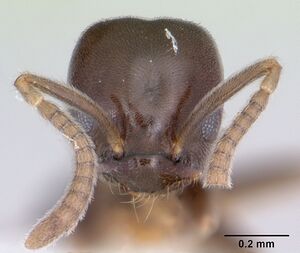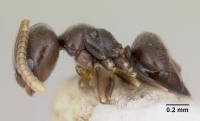Bothriomyrmex paradoxus
| Bothriomyrmex paradoxus | |
|---|---|

| |
| Scientific classification | |
| Kingdom: | Animalia |
| Phylum: | Arthropoda |
| Class: | Insecta |
| Order: | Hymenoptera |
| Family: | Formicidae |
| Subfamily: | Dolichoderinae |
| Genus: | Bothriomyrmex |
| Species: | B. paradoxus |
| Binomial name | |
| Bothriomyrmex paradoxus Dubovikoff & Longino, 2004 | |
The first member of the genus to be found in the New World.
Identification
Dubovikoff & Longino (2004) - Queen with short suberect setae on mesosoma and gaster; queen mesosoma short and high (TI > 0.64); worker mesosoma with impressed metanotal groove.
All the traits typical of the genus: 4:3 palp formula, strongly reduced hypostomal margin, and a characteristic venation on the forewing of the queen (closed discoidal cell, RM-2 absent, and radius reaching costal margin of wing).
Bothriomymex paradoxus belongs to Bothriomyrmex s.s. and not among the Asian and Australian species (Dubovikoff unpub.). However, it does not fit cleanly into one of the Palearctic species groups. The short suberect setae on the queen's mesosoma and gaster is a trait also found in members of the Bothriomyrmex syrius group (Bothriomyrmex syria, Bothriomyrmex turcomenicus, Bothriomyrmex communista, Bothriomyrmex kusnezovi and Bothriomyrmex urartus). However, B. paradoxus differs from all species of this group by the higher and shorter mesosoma of the queen. TI of B. paradoxus is 0.64, while other species have TI < 0.50. Also, the impressed metanotal groove on the worker is a trait found in members of the Bothriomyrmex gibbus complex and not in the B. syrius group.
There are two Bothriomyrmex in the new world. . .
Prebus and Lubertazzi (2016) - The following character combination distinguishes Bothriomyrmex enigmaticus from Bothriomyrmex paradoxus: palp formula 2,3; medial lobe of clypeus not strongly projecting: flat, or with a broad, shallow concavity anteriorly. Long, paired setae on medial clypeal lobe separated by 2/3 their length or more. Eyes large: OI 23.1–24.7. Head box-like, with occipital corners narrowly rounded.
Neotropical Bothriomyrmex (workers):
- Palp formula 4,3 (see fig. 3d in Dubovikoff & Longino 2004); medial lobe of clypeus strongly projecting beyond the lateral lobes; anterior margin evenly rounded to flat, never concave medially; paired long setae on anterior margin of medial lobe separated by less than ⅔ of their length (Fig. 2a, see image in description section below). . . . . B. paradoxus
- Palp formula 2,3 (Fig. 2d); medial lobe of clypeus weakly projecting; anterior margin flat to broadly concave medially; paired long setae on anterior margin of medial lobe separated by 2/3 of their length or more (Fig. 2b, see image in description section below). . . . . Bothriomyrmex enigmaticus
Distribution
Latitudinal Distribution Pattern
Latitudinal Range: 10.91666667° to 10.33333°.
| North Temperate |
North Subtropical |
Tropical | South Subtropical |
South Temperate |
- Source: AntMaps
Distribution based on Regional Taxon Lists
Neotropical Region: Costa Rica (type locality), Honduras.
Distribution based on AntMaps
Distribution based on AntWeb specimens
Check data from AntWeb
Countries Occupied
| Number of countries occupied by this species based on AntWiki Regional Taxon Lists. In general, fewer countries occupied indicates a narrower range, while more countries indicates a more widespread species. |

|
Estimated Abundance
| Relative abundance based on number of AntMaps records per species (this species within the purple bar). Fewer records (to the left) indicates a less abundant/encountered species while more records (to the right) indicates more abundant/encountered species. |

|
Biology
Dubovikoff & Longino (2004) - Bothriomyrmex paradoxus is known from two different collections from widely separated localities in Costa Rica. One collection was made in February 2003, during the Project ALAS expeditions to the 500m site on the Volcan Barva transect. The expeditions were based at the “El Ceibo” guard station, on the west bank of the Rio Peje. The station building itself is in pasture abutting mature rainforest. A few meters inside the forest a large tree had fallen sometime during the months prior to the expeditions. A few of the tree's leaves were still green; most were brown but still attached to branches. There were still extensive epiphyte mats covering the trunk and major branches. Longino collected from beneath these mats and found Bothriomyrmex workers and brood piles to be abundant beneath most of the mats. Large Margarodidae (Hemiptera, Coccoidea) were also scattered amongst the Bothriomyrmex. Other ant species occurred under the mats and were somewhat interdigitated with the Bothriomyrmex, although much less abundant. These included Hypoponera opacior, a small yellow Solenopsis, and Tapinoma.
Smaller nests or aggregations were also found of Crematogaster sotobosque and Pheidole biconstricta. One part of the tree, near the pasture edge, was being invaded by Solenopsis geminata. I found only workers and brood. Ronald Vargas of Project ALAS collected more from the same tree in April. His collections included two adult males.
The second collection was also made in February of 2003. John Noyes of The Natural History Museum (London) was taking large sweep samples from vegetation at several Costa Rican localities and extracting Encyrtidae, his primary focal taxon. He also separated ants and sent these samples to Longino. Each sample contained hundreds to thousands of ants, including many alates. In the sample from Estación Cacao were about a dozen males and a similar number of dealate queens of Bothriomyrmex. The habitat at Estación Cacao is a mosaic of mature montane moist forest with epiphyte-laden trees and abandoned pastures. This is a site on the Pacific slope of the northern-most cordillera in Costa Rica, 170km from the El Ceibo site on the Atlantic slope.
This is the first collection of the genus Bothriomyrmex in the New World. The occurrence in mature forest habitats and the fact that it is not conspecific with any known Old World species suggest it is truly native and not a recent introduction. Bothriomyrmex paradoxus may be a very old species, long isolated from the Palearctic species. Other putative relict species in Central America include Technomyrmex fulvus and Perissomyrmex snyderi. Central America appears to be a refuge for several ancient lineages of ants.
Castes
Images from AntWeb
   
| |
| Paratype Bothriomyrmex paradoxus. Worker. Specimen code jtlc000003512. Photographer April Nobile, uploaded by California Academy of Sciences. | Owned by CAS. |
Nomenclature
The following information is derived from Barry Bolton's Online Catalogue of the Ants of the World.
- paradoxus. Bothriomyrmex paradoxus Dubovikoff & Longino, 2004: 3, figs. 1-5 (w.q.) COSTA RICA.
- Type-material: holotype queen, 14 paratype workers, 6 paratype queens, 5 paratype males.
- Type-locality: holotype Costa Rica: Prov. Guanacaste, Guanacaste Consevation Area, Estación Cacao, 10°55’N, 85°30’W, 1100 m., 22.ii.2003 (J.S. Noyes); paratypes: 6 queens, 5 males with same data, 9 workers Costa Rica: Prov. Heredia, 11 km. SE La Virgen, 500 m., 19.iv.2003, 05-RVC-007 (R. Vargas), 5 workers with same data but 16.ii.2003, JTL4938 (J. Longino).
- Type-depositories: INBC (holotype); CASC, INBC, LACM, MCZC, UCDC, USNM, ZISP (paratypes).
- Status as species: Prebus & Lubertazzi, 2016: 8 (in key).
- Distribution: Costa Rica.
Unless otherwise noted the text for the remainder of this section is reported from the publication that includes the original description.
Description
Worker
Paratype measurements (average for 5 workers): HL 0.586; HW 0.520; SL 0.434; PH 0.239; CI 0.888; SI 0.742.
Palp formula 4:3; medial hypostoma absent; head with two long setae on the frons, two on the posterior clypeal margin, and many curved setae on the anterior clypeal margin; metanotal groove impressed; dorsal face of propodeum rounded, much shorter than posterior face; petiolar node scale-like, tall, inclined anteriorly; ventral margin of petiole with prominent lobe; gaster with long setae on posterior margins of tergites; pubescence short and dense over entire body; body dark brown, with lighter antennae and legs.
Queen
Holotype measurements: HL 0.600; HW 0.526; SL 0.424; TL 0.697; TH 0.448; PH 0.227; TI 0.643; CI 0.876; SI 0.706. Paratype measurements (average for 3 queens): HL 0.600; HW 0.543; SL 0.436; TL 0.700; TH 0.450; PH 0.257; TI 0.643; CI 0.905; SI 0.726.
Palp formula 4:3; head oblong, with rounded posterolateral vertex margins; suberect hairs of variable length on genae; clypeus broad, width in center 0.2 mm (average for 4 queens), with curved setae on anterior margin; mandible long, with outer and basal margin subparallel, masticatory margin with three teeth and 4-5 denticles; mesosoma short and high, with erect setae on dorsum and posterior face of propodeum; wings with closed cubital and radial cells; petiole with strongly developed ventral lobe, dorsal scale inclined anteriorly; gaster with many long setae on posterolateral margins of tergites; body dark brown; entire body with short suberect pubescence, distance between hairs subequal to length.
Male
Paratype measurements (average for 3 males): HL 0.457; HW 0.479; SL 0.257; OL 0.171; PH 0.179; OI 0.667; CI 1.047; SI 0.563.
Scape long, projecting beyond outer eye margin (in face view) by about half of its length; propodeum rounded, without differentiated dorsal and posterior faces; petiole with short anterior peduncle; petiolar node low, thin, vertical; ventral margin of petiole with small anterior denticle and strongly developed medial lobe; sagitta thin, with apex weakly folded down.
Larva
Body with two protuberances on the prothorax, located ventrolaterally; hairs short; eight pairs of spiracles.
Type Material
Holotype queen: Costa Rica, Prov. Guanacaste, Guanacaste Conservation Area, Estación Cacao, 10°55'N 85°30'W, 1100m, 22 Feb 2003, tropical montane moist forest, sweep sample (J. S. Noyes), specimen barcode JTLC000004280 Instituto Nacional de Biodiversidad.
Paratypes: 3 queens and 3 males, same data as holotype ZIN; queen and 2 males, same data as holotype Museum of Comparative Zoology; 2 queens, same data as holotype Los Angeles County Museum of Natural History, INBio]; 5 workers, Costa Rica, Prov. Heredia, 11 km SE La Virgen, 10º20´N 84º04´W, 500m, 19 Apr 2003, coll. R. Vargas C., 05–RVC-007 [ZIN]; 4 workers, same data Musee d'Histoire Naturelle Genève; 5 workers, same data but 16 Feb 2003, coll. J. Longino (JTL4938) [same colony] California Academy of Sciences, INBio, LACM, University of California, Davis, National Museum of Natural History.
Although it is typical to choose workers as holotypes of ant species, we have chosen a queen because queens exhibit much greater morphological differences among species in Bothriomyrmex. This is true of several dolichoderine genera, including Azteca and Tapinoma. For example, Longino (1991) used queens as holotypes in taxonomic work on Azteca.
Etymology
Named for the paradoxical occurrence of this species in the New World, when the genus was previously considered strictly Old World.
References
- Dubovikoff, D.A.; Longino, J. T. 2004. A new species of the genus Bothriomyrmex Emery, 1869 (Hymenoptera: Formicidae: Dolichoderinae) from Costa Rica. Zootaxa 776: 1-10 (page 3, queen, male described)
- Lubertazzi, D. 2019. The ants of Hispaniola. Bulletin of the Museum of Comparative Zoology, 162(2), 59-210 (doi:10.3099/mcz-43.1).

